New research warns of increased hurricane risk to the northeast United States
Over the past 450 years, hurricanes have gradually moved northwards from the western Caribbean towards northern North America, according to the research funded through the HURRICANE project, led by the UK’s Durham University. The project team suggest that this change in hurricane trajectories has been caused by the expansion of atmospheric circulation belts driven by increasing carbon dioxide emissions. This is bad news for major cities such as New York and Boston situated on the north eastern seaboard as they could now come under increased threat from future hurricanes and will need to better prepare themselves for their potential impact. Published in the journal ‘Scientific Reports’ in November 2016, the study saw researchers reconstruct hurricane rainfall for the western Caribbean dating back over four centuries by analysing the chemical composition of a stalagmite collected from a cave in southern Belize. They found that the average number of hurricanes at the Belize site decreased over time. When the hurricane history of Belize was compared with documentary hurricane records from locations such as Florida and Bermuda, this showed that Atlantic (Cape Verde) hurricanes were moving to the north rather than decreasing in total numbers. Impact of industrialisation In particular, the researchers found that even though natural warming over the centuries had some impact on shifting hurricane tracks, the research team found that hurricane activity in the western Caribbean decreased markedly in the late nineteenth century. This coincides with a major industrial boom as the region was rapidly integrated into the growing world economy. This economic growth saw an increasing level of carbon dioxide and sulphate aerosol emissions into the atmosphere. The research team outlined how initial regional cooling of the Northern Hemisphere due to increased industrial aerosol emissions should have pushed the hurricane tracks southwards since rapid industrialisation. However, rising amounts of atmospheric carbon dioxide had overridden this effect by expanding the Hadley cell, a pattern of circulating air in the Earth’s tropical belt. This subsequently pushed hurricane tracks further north, away from the Caribbean towards the US north eastern seaboard. Importantly, the research suggests that from the late nineteenth century, manmade emissions have become the main driver behind shifting hurricane tracks by altering the position of global weather systems. Sandy sets a precedent In 2012, Hurricane Sandy struck the Caribbean and much of the eastern US seaboard, continuing as far north as the eastern coastal Canadian provinces. A large number of US states were affected by Sandy, with New York and New Jersey suffering the most. In total 233 people died as a result of the storm and the damage caused was said to have run into tens of billions of dollars. Dr Lisa Baldini, the study’s lead author commented: ‘Given the devastation caused by Hurricane Sandy, it is important that plans are put in place to protect against the effects of similarly destructive storms which could potentially occur more often in the future.’ Co-author Dr James Baldini added: ‘Although hurricane tracks have gradually moved northwards away from the western Caribbean, rising sea surface temperatures could promote the development of cyclonic storms within the western Caribbean... however, increased sea surface temperatures also provide extra energy, potentially fuelling larger storms. We therefore need to prepare for the effects of more frequent landfalls of larger storms along the north east coast of the United States and stronger storms impacting the Caribbean.’ For more information, please see: CORDIS project page
Countries
United Kingdom



